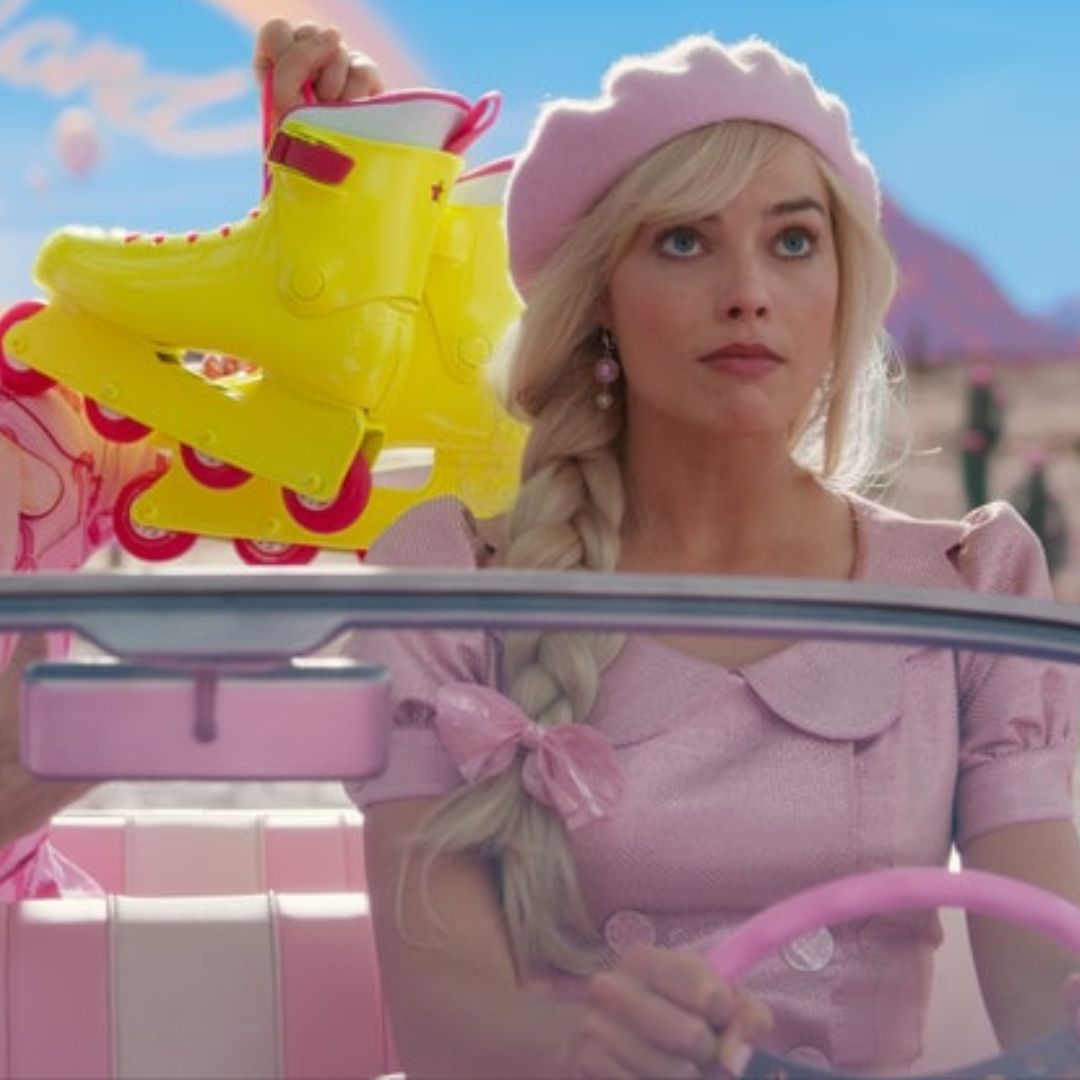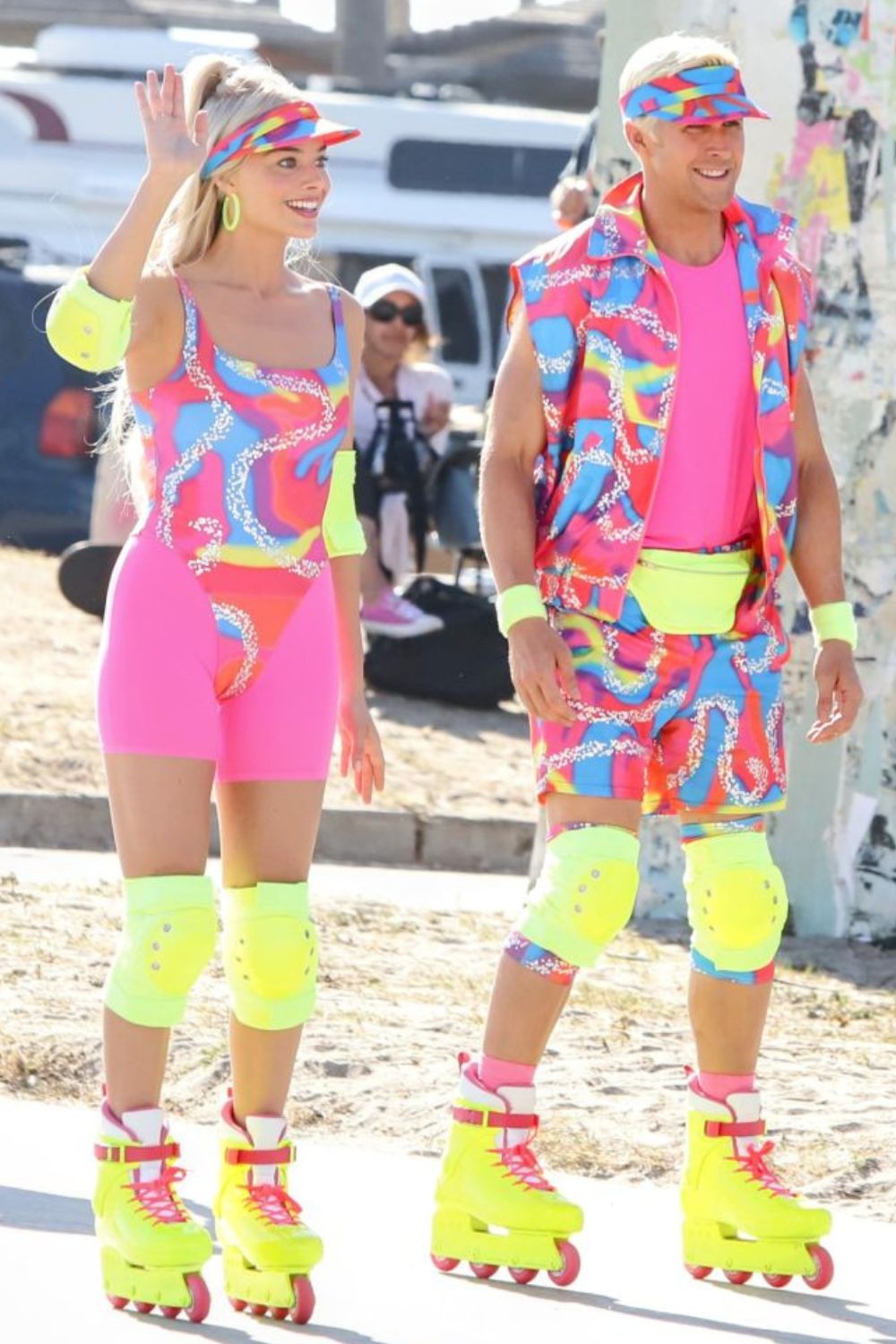
The latest Barbie trailer dropped this week and, if you're anything like us, you're pretty excited. The trailer features pink everything, choreographed dance routines, and of course, Barbie cruising around on skates. It's her workout of choice, which is why to mark the occasion, we've consulted the experts to bring you a complete guide to roller skating for beginners.
"Did you bring your rollerblades?," Barbie asks Ken in the teaser trailer. "I literally go nowhere without them," Gosling responds.
While Robbie is no stranger to skates - she rolled around on the blades in Suicide Squad and ice-skated her way through I Tonya - many of us are. Sure, the #rollerskating Tiktok hashtag already has over ten billion views and counting, but many (myself included) will still feel a bit wobbly at the thought of even attempting to skate.
Not with the help of the top roller skating pros below, who've shared all their top tips on how to master the art. Plus, one woman shares how skating has transformed both her mental and physical fitness. Keep scrolling.
Roller skating for beginners: your guide
What is roller skating?
In short, it's the act of travelling around on small wheeled skates. It can be quite a workout, depending on how far and long you skate for and requires a certain knack to get just right (read: not end up on the floor).
While it's been popular since as far back as the 1880s, roller skating really took off in the 1930s, with roller-skating marathons and roller derbys.
Fun fact for you: roller skates were also in short supply globally during a surge in popularity during the Covid-19 lockdowns of 2020 and 2021.

What are the benefits of roller skating?
Did you know? "Skating is a great all-over workout," shares Sarah Lewis, rollerskating instructor and founder of Roll Happy. "Lots of people think that it only uses your legs, but you're also constantly using your core to keep you upright."
Not just that, but rollerblading or skating can be a phenomenal (and fun) way to build muscle tone, explains Longevity Fitness personal trainer Lotti Sorrel. "It's also great for boosting joint health, soft tissue strength, balance and proprioception, keeping age-related issues at bay and making you feel unstoppable."
Do you need knee pads?
Let's be honest - many of us don't give roller skating a chance for fear of falling over (myself included). That said, our experts share that learning how to fall is a non-negotiable which will not only keep you injury-free but ease any anxieties you have about getting out on your skates.
"I'd recommend you wear knee pads and wrist guards as a minimum while learning, with elbow pads and helmets an optional extra," encourages Lewis. "Feeling safe whilst you're starting out can take some of the fear out of it and make the process more fun. You are bound to take a few tumbles whilst learning so we show our beginners how to fall safely and protect themselves."
On the how-to-fall front - our experts advise picking a direction and leaning into it. Trying to fall on your side (read: avoid your tailbone, where possible) and tucking your hands into balls is often less painful. If you find yourself falling forwards, they recommend trying to break the fall by putting one knee down, which has the potential to minimise the full impact of the tumble.
The below video will come in handy, too.
Should you practice at home before heading out?
If you don't want to be seen Bambi-ing around your local park, then you may want to start out at home in the comfort of your own space.
"Getting used to where your weight should be and working on your balance can be done anywhere," Lewis explains. "Car parks and driveways are also great spots to take your first steps - just make sure the surface is flat first. You will know about it pretty quickly if you hit a slope," she warns.
8 tips for roller skating for beginners
"One thing I wish I'd known when I started out was the importance of stretching properly," shares Kadija Kamara who's skated every day for the past three years. "It's essential for all types of sports and can mean that you can avoid a lot of muscle pain when skating regularly."
This stretching workout or our guide to warm up exercises might come in handy, here. Other roller skating for beginners tips span:
1. Keep your knees soft and bent
"...And your weight forwards," advises Lewis. "When starting out, I'd recommend holding your arms out in front, palms face down as if you're sitting at a desk. This will keep your weight over your toes, and stop the wheels from rolling out from underneath you."
2. Relax your shoulders
Next up? Make sure to be mindful of the tension in your shoulders, too.
"Take a deep breath, roll your shoulders back, and then relax them," advises the pro. "You can hold a lot of tension in our shoulders when you're scared."
3. Avoid looking at your feet
Sounds simple, isn't in practice.
"Take it nice and slowly and try not to look at your feet - I know you want to, but it tips your balance off and will make everything much harder," Lewis explains. "Trust that they are doing the right thing and look where you want to go instead - in other words, not at the floor."

4. Bend your knees to move forwards
Ready to get going? Lewis advises focusing on your breathing and slightly bending your legs to give you the push off you need.
5. Have patience
"Learning to skate takes time on your wheels and it's not something that happens overnight," reassures the expert.
Remember to enjoy the process of learning and try not to compare yourself to other skaters - it's not a race and practice really does make progress.
6. Make sure you know how to fall
Our handy guide above will help, not only in avoiding injury, but also in easing any anxieties you have around falling.
Know this: falls will happen, but as long as you land correctly and with good form, you should be good to get back up and go, reckon the experts.
7. Try not to walk
It's almost intuitive, but walking on skates is a surefire way to falling over - fast.
Instead, shift your weight back and forth between the skates and push forward, rather than stepping forward.
8. Know how to stop
The trick here is to slowly "reduce the speed rather than trying to completely stop," says German from London Skate Life. "This gentle approach to the stop will help develop muscles for stronger stops like slides."
When you're ready to stop skating, it's as simple as you want to bend your knees and reach your arms out in front of you. If your skates have toe breaks, slowly and gently push down on your toe (but be gentle - too hard and you may go head over heels).
The bubble or plough stop is the one you may find yourself doing most naturally, which involves pushing your skates and bringing them back in while gradually increasing pressure on the big toes.
"Rollerskating changed the way I workout forever"
Kadija Kamara is an artist who started skating back in 2020. Now, she shares that the hobby has transformed both her fitness and mental health.
"I'm not someone who likes to go to the gym, so finding my love for rollerskating has hugely improved my fitness," she shares.
"My cardio and core-musical strength are better, plus it's been incredible for my mental health."
"I've found a way of working out that I love so much - I honestly can’t imagine my life without out. I love the fact that I stay fit without even thinking about it too much, and honestly believe that the best way to stay fit is by discovering (and sticking with) a workout that brings you joy."
3 roller skating tutorials for beginners
Ready to try roller skating? As you become more of a pro, you'll get to know the roller skating terminology (we're looking at you, bubbles and baby jumps).
Check out the videos below for some more inspiration.
1. An easy guide to skating
2. 4 drills for beginner roll skaters
@rollinwithkate ♬ Better Days (Sped up Version) - Dominic DiTanna
3. Top skating tips for beginners
@marilyn_tantrum ♬ BIZCOCHITO - ROSALÍA







